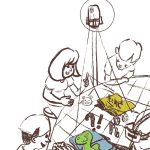PhD Thesis, Jingya Li
Today’s children are born in a world with rapid growth of multimedia technologies and are used to handling all kinds of digital devices, they furthermore appear to be attracted to digital games and spend a lot of time with them. Consequently, digital games for educational purposes, also known as serious games, have become an increasingly important method for learning and instruction. However, empirical evidence of serious games being more motivating is still lacking, and as many serious games focus on single-player instruction, serious gameplay can sometimes be a physically and socially isolating experience.
Recently AR technology has become an emerging solution to positively impact learning and motivation, providing unique benefits of visualization and interaction between users and digital content embedded within the physical environment. In this research, we designed, prototyped, evaluated, and iterated multiple AR serious games as probes to investigate the main research objective, which was to find:
Design recommendations for AR serious games to positively influence the learning motivation and experience of elementary school children.
Our research follows a research through design method. We integrated the Selfdetermination theory and Playful Experience framework with the technical opportunities of AR and game design mechanics. We formulated the main research question as:
How to design AR serious games based on notions of perceived competence, relatedness, and autonomy in Self-determination theory to enhance children’s learning motivation and experience?
To answer the research question, we divided our research into four main studies, each including game development and a formal experiment with users. The second, third, and fourth study each addresses one of the three components of SDT, and each study builds upon the insights gathered in the previous.
In the first study, we explored the game concepts by conducting participatory design sessions with elementary school children and a cross-culture study with 38 participants aged 7-8 from the Netherlands and China. Through this study, we came up with our basic game concepts and concluded design insights regarding the motivational effects of AR and the cultural differences.
In the second study, we designed a new game based on the design insights from the first study and notions of perceived competence in SDT, investigating how children react to two different types of interactions and two different types of feedback mechanics when performing exercises in AR serious game with 32 participants aged 7-8.
Then, we designed and implemented a new game considering the design implications obtained from the first and second study and notions of perceived relatedness derived from SDT, to scrutinize the effect of social interactions in AR serious games on children. We conducted another participatory design session and designed a game with collaboration and competition elements variations, and conducted a user study with 28 participants aged around 9.
Lastly, we designed an AR game inspired by notions of perceived autonomy with four different versions, once again based on the results from the previous studies, and tested pathways to immerse children to explore and play in an AR fantasy world. We conducted an experiment with 81 participants aged around 8.
Generally, this research explored the concepts, prototypes, and experiments of incorporating AR with serious games and found great potential to improve the learning motivation and social interactions for elementary school children. We realized multiple AR prototypes inspired by SDT and generalized a set of design guidelines using examples, which are intended to help future related designs in AR serious games.
